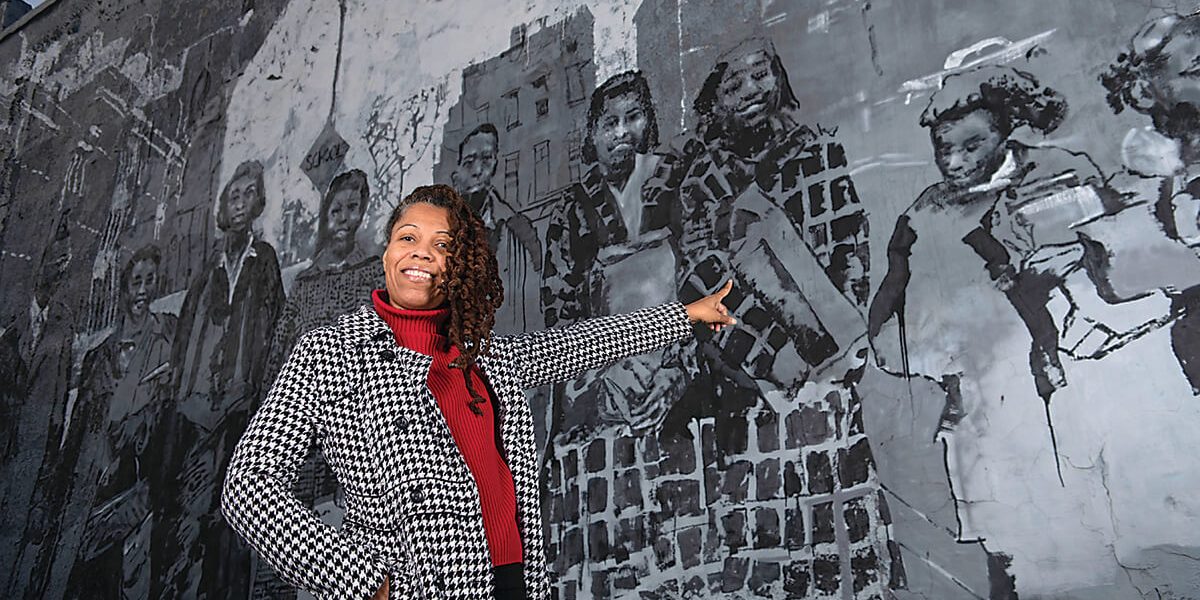Arts & Culture
Picture This
Grandson of longtime Baltimore Afro-American photographer Henry Phillips preserves his one-of-a-kind collection.
Monica Bland isn’t sure what made her veer from her usual route. She was picking up her godchildren one afternoon last year when she mistakenly took a different turn and suddenly found herself staring up at a two-story image of a family of nine shopping for Easter shoes. It was a mural recreated from a 1956 photograph in the Afro-American newspaper. “And I realized, as the faces in the mural are looking back at me, that I know this family,” recounts Bland, who runs a small local business. “It’s my grandparents, all my aunts, my uncle, and my mother.”
Michael Owen, of Baltimore Love Project renown, painted the larger-than-life black and white image as it appeared in print on Holy Saturday (the original photograph graces the cover of our February issue). It’s not quite photorealism. But it’s close enough given the rough-concrete sidewall of the Midtown rowhouse where the work towers over an otherwise empty lot.
In fact, the mural is a collaboration between Owen and photographer Webster Phillips, whose grandfather, Henry Phillips, shot the picture for the Afro-American. The plaque next to the mural implored viewers to reach out to the younger Phillips if they could ID the people featured: “Help us save Baltimore history.” Startled, and moved, Bland called.
“I was blown away,” Phillips says. “You hope you get a call like that. You don’t really expect it.”
The Dean family buying Easter shoes. From left, Walter, Ruth, Annette, Patricia, Ransom, Delores, Sonia, Gloria, and Janice.
Phillips has spent the past several years digitizing his grandfather’s work—some 10,000 images to date, mostly shot between 1945-1965—organizing gallery shows, posting photographs across social media, and now venturing to senior centers in hopes of identifying more folks in the photos.
Fortunately, the elder Phillips, who died in 1993, stored all his negatives, allowing for the creation of new, authentic hi-resolution reproductions. (There’s actually three generations of Phillips photographers. Henry Phillips’ son and Webster Phillips’ father, Irving Phillips, became The Sun’s first black photographer.) There was simply no one else documenting mid-century Black Baltimore life like Henry Phillips did at a time when new flash and film technology enabled photographers to ditch their tripods, become mobile, and capture moments as they happened.
To date, the cache includes photos of Louis Armstrong blowing his horn backstage at the Royal Theatre, Billie Holiday shopping on Pennsylvania Avenue, Ella Fitzgerald playing ping pong in a fur coat, Duke Ellington performing in Baltimore, Joe Louis boxing and golfing in Baltimore, Jackie Robinson at spring training, and a singularly poignant photo of former First Lady Jacqueline Kennedy comforting Coretta Scott King in a private moment at her husband’s funeral in 1968.
Equally compelling, significant, and gorgeous are the portraits that Henry Phillips took of everyday Baltimoreans—a child eating cotton candy, students roller-skating at recess, the first black graduate in a sea of white faces and white uniforms at the Naval Academy, women on their way to church in their Sunday best, and Afro-American cartoonist Thomas Stockett at his drafting table.
“I thought Henry Phillips was a very quiet, understated man on a mission,” Leslie King-Hammond, founding director of the Center for Race and Culture at the Maryland Institute College of Art, once said. “He told the other side of the story. That, in spite of the hardships of being an African American in this country, we still made a life of substance and meaning, and dignity and elegance.”
I. Henry Phillips Sr. in the Afro-American newspapers dark room with son Frank Phillips.
Webster Phillips says, for him, the best thing about working with his grandfather’s collection isn’t actually the photographs themselves, but the feeling of walking in his grandfather’s shoes.
“He took pictures everywhere he went,” Phillips says. “He’d come home from work, stop, and take a portrait of someone he met outside a corner store, develop it, and give to him. And then, I’m also with him at the 1963 March on Washington. I’ve looked at more than 10,000 of his photographs. Think about it. It’s like going through your grandfather’s Instagram or Facebook. Wouldn’t you like to do that?”
